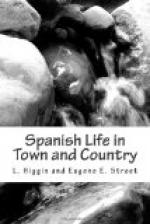Whatever the cause, however, there is hardly any general literature; almost the only books (not professional or technical) which are published, appear to be translations of French novels—not of the highest class. Perhaps in the study of archaeology and folklore is to be found the most cultured phase of Portuguese intelligence. The Archaeological Society of Lisbon strives to do good work, and has a museum with interesting relics in the old church of the Carmo, itself one of the most interesting and graceful ruins left out of the havoc caused by the great earthquake.
As might be expected under such circumstances, the newspapers are, with few exceptions, of the “rag” variety. Conducted for the most part by clever young fellows fresh from Coimbra, they are violent in their views and incorrect in their news, especially with regard to foreign intelligence. They have some influence, no doubt, but not so much as the same type of newspaper in France. The habitual want of veracity of the Portuguese character is naturally emphasised in the newspapers, and no one in his senses would believe any statement made in them.
A sure sign of the decadence of intellectual life, as well as of commercial activity, is to be found in the postal service, with its antiquated methods and imperfect arrangements. It is administered in a happy-go-lucky manner, which amuses at the same time that it annoys. Truly, with the post-office, it is well constantly to repeat to one’s self the phrase: “Patience! all will be well to-morrow!” Probably it won’t be well; but none but a foolish Englishman or Frenchman or German will bother about such a little matter.
A kindly, brave, docile, dishonest, patient, and courteous people, who, to quote Napier “retain a sense of injury or insult with incredible tenacity;” and a due observance of their customs and proper politeness are so readily met, and friendly advances are so freely proffered, that a sojourn amongst them is pleasant enough. I have wondered that the tourist has not found his way more into this smiling land, though, no doubt, his absence is a matter of congratulation to the traveller in these regions. The country has many beauties, the people and their costumes are picturesque, and the cost of living—even allowing for a considerable percentage of cheating—is not excessive. There is, I suppose, a want of the ordinary attractions for the pure tourist or globe-trotter. There are churches, monuments, and objects of interest in goodly numbers, and there is beautiful scenery in great variety; but the true attraction to a thoughtful visitor lies in the contemplation of the people themselves.
The Portuguese, taken as a whole, are not a good-looking race. The women, who, as a rule, are very pretty as little girls, lose their good looks as they grow up, and are disappointing when compared with the Spaniards. Sometimes one comes across fish- or market-women of considerable comeliness, which, when conjoined to the graceful figure and poise induced by the habitual carriage of heavy weights on the head and the absence of shoes, makes a striking picture. The costume is attractive, and the wealth of golden ear-rings, charms, chains, and such like, in which these women invest their savings, does not somehow seem anomalous or incongruous, though shown on a background of dirty and ragged clothing.




